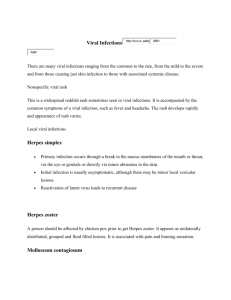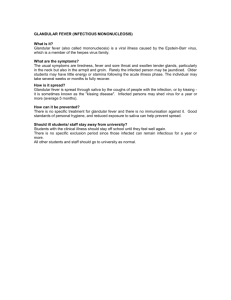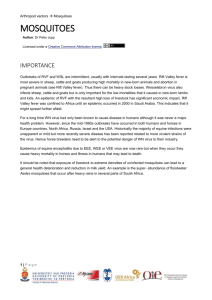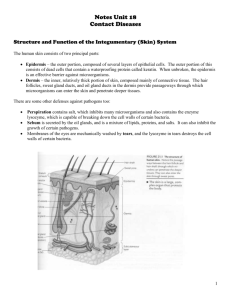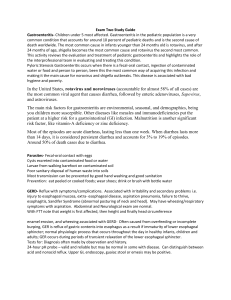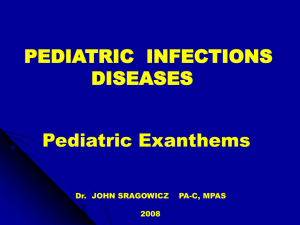CIL/IML Infectious Disease Chapter 9, Part 1
advertisement
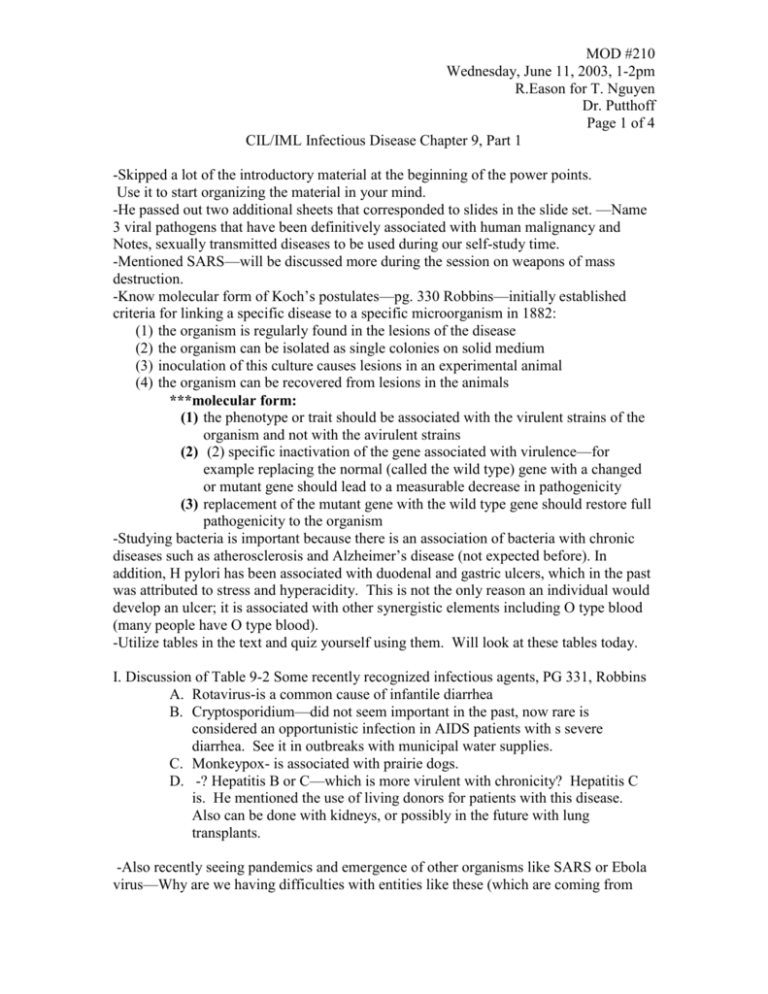
MOD #210 Wednesday, June 11, 2003, 1-2pm R.Eason for T. Nguyen Dr. Putthoff Page 1 of 4 CIL/IML Infectious Disease Chapter 9, Part 1 -Skipped a lot of the introductory material at the beginning of the power points. Use it to start organizing the material in your mind. -He passed out two additional sheets that corresponded to slides in the slide set. —Name 3 viral pathogens that have been definitively associated with human malignancy and Notes, sexually transmitted diseases to be used during our self-study time. -Mentioned SARS—will be discussed more during the session on weapons of mass destruction. -Know molecular form of Koch’s postulates—pg. 330 Robbins—initially established criteria for linking a specific disease to a specific microorganism in 1882: (1) the organism is regularly found in the lesions of the disease (2) the organism can be isolated as single colonies on solid medium (3) inoculation of this culture causes lesions in an experimental animal (4) the organism can be recovered from lesions in the animals ***molecular form: (1) the phenotype or trait should be associated with the virulent strains of the organism and not with the avirulent strains (2) (2) specific inactivation of the gene associated with virulence—for example replacing the normal (called the wild type) gene with a changed or mutant gene should lead to a measurable decrease in pathogenicity (3) replacement of the mutant gene with the wild type gene should restore full pathogenicity to the organism -Studying bacteria is important because there is an association of bacteria with chronic diseases such as atherosclerosis and Alzheimer’s disease (not expected before). In addition, H pylori has been associated with duodenal and gastric ulcers, which in the past was attributed to stress and hyperacidity. This is not the only reason an individual would develop an ulcer; it is associated with other synergistic elements including O type blood (many people have O type blood). -Utilize tables in the text and quiz yourself using them. Will look at these tables today. I. Discussion of Table 9-2 Some recently recognized infectious agents, PG 331, Robbins A. Rotavirus-is a common cause of infantile diarrhea B. Cryptosporidium—did not seem important in the past, now rare is considered an opportunistic infection in AIDS patients with s severe diarrhea. See it in outbreaks with municipal water supplies. C. Monkeypox- is associated with prairie dogs. D. -? Hepatitis B or C—which is more virulent with chronicity? Hepatitis C is. He mentioned the use of living donors for patients with this disease. Also can be done with kidneys, or possibly in the future with lung transplants. -Also recently seeing pandemics and emergence of other organisms like SARS or Ebola virus—Why are we having difficulties with entities like these (which are coming from MOD #210 6/11/2003 1-2pm Page 2 of 4 animal reservoirs)? One reason is global travel. Also, we are exposed to toxins constantly that our ancestors were not. Sitting in front of a computer is associated with electromagnetic radiation. There are also numerous studies showing children with ADHD sitting close to a t.v. screen or computer monitor have exacerbation of their symptoms. There are high voltage electrical wires that run close to our homes (some studies have shown that these cause an increase in lymphoproliferative disorders.) Cell phones use microwave transmission. We eat processed foods. All are controversial, and possibly could cause mutations in human cells (as shown in some studies) that are rapidly proliferating. They should also affect other organisms (viruses, bacteriophages, bacteria, etc.). Thus, global travel, encroachment on environmental ecosystems, and the exposure to a spectrum of toxins causing mutational events (benzene, wastes, etc.) could cause changes such as this. He advised to take antioxidants. -Establishment of human disease—look at 2 things—the virulence properties of the pathogenic organism and the host response to the organism. The host response can sometimes protect the organism. II. Table 9-3, p. 332 Classes of Human endoparasites and their habitats, Robbins—much is review material—use as a reference. A. Rickettsia prowazekii with Brill Zinser disease-cause typhus fever—is different from typhoid fever which is Clinical Microbiology caused by Salmonella typhi. B. Mycoplasma pneumoniae C. Staph epidermidis—patients with a wound infection with this organism are usually immunocompromised or have a significant disruption of the skin and not caring for it properly (cleaning it, take antibiotics, etc.) D. Streptococcus pneumoniae causes lobar pneumonia and meningitis in adults. The lobar pneumonia results from. (only involves 1 lobe) the body mounting an immune response that localizes the infection to the one lobe. (rem from anatomy-right lung with 3 lobes and left with 2; the left has the lingula which could be considered a third lower lobe, but there is no sulcus dividing it from the other lobes) The infection, however, can spread via the pulmonary vasculature (the alveolar capillaries are very small—12 microns in average diameter. In addition, the lungs have a dual blood supply from pulm arteries and bronchial art) and cause sepsisseptic shockdeath. E. Candida albicans- if colonizing the throat and esophagus of what appears to be a normal, healthy adult or child, consider a T-cell deficiency. Needs further evaluation for a malignancy, a lymphoreticular malignancy or H.I.V. -will rarely see Trypanosoma or Leishmania F. Enterobius vermicularis—pinworm—common in children, c/o perianal itching--use scotch tape test in the middle of the night to pick up eggs (is when the female lays the eggs in the perianal area) Treat with mebendazole or pyrantel pamoate G. Wuchereria bancrofti-transmission by bite of infected mosquito, with repeated exposures causes elephantitis due to buildup of fibrotic tissue in the lymphatics of the lower extremities and genitals (where the dead filariae MOD #210 6/11/2003 1-2pm Page 3 of 4 remain after mating and producing offspring.). The edematous skin becomes thick and scaly and is very disfiguring. The legs look like elephant legs. Treat with diethylcarbamazine. H. Mentioned Trichinella spiralis and Taenia solium—both helminths contracted from eating uncooked pork. III. Review of Table 9-4 Human viral diseases and their pathogens, pg 333, Robbins A. Adenovirus-is a DNA virus that causes URI and lower respiratory infections. It is a common upper respiratory infection, but not lower. Often pts have a unilateral conjunctivitis with it, called in the past shipyard eye. B. Echovirus-not common C. Rhinovirus-extremely common, esp. in adults, probably the most common cause of the common cold. It has numerous serotypes and mutates rapidly D. Coxsackievirus—under disease expression- pleurodynia-def—pleuritic chest pain—pain upon deep inspiration or coughing—usu of a stabbing nature, is usually unilateral and episodic with headache, fever, vomiting, myalgias, abdominal and neck pain—treatment is supportive. Associated with URI and lower respiratory infections. Causes hand, foot and mouth disease (painful ulcerative and vesicular lesions of the oral mucosa and tongue with vesicular or red papular lesions of the hands and feet that is highly infectious with mild fever and malaise) in children. In adults, is the most common cause of viral myocarditis. E. Coronavirus—URIs and SARS. F. Influenza viruses-rapidly mutate. Thus, the vaccine for influenze is approximately only 70% protective against the disease. Is not the stomach flu—usu has no gastrointestinal manifestations—is an upper and lower respiratory tract disease that presents with arthralgias, myalgias, malaise, high fevers, lethargy. It may cause death especially in elderly and children. Worst epidemic of influenza was in 1916 and 1918, with 40 billion died worldwide. G. Mumps-can be contracted by adult males and cause orchitis-inflammation or infection of the testes that may cause infertility. Usually prevented by the MMR vaccine. Can also cause meningitis and encephalitis. H. Hepatitis viruses include Hepatitis G. I. Rubella- important in pregnant patients in the early weeks/first trimester, crosses placenta and causes terrible congenital defects. J. Parvovirus-is a single stranded DNA virus that is the smallest isocahedral virus. B19 causes erythema infectiosum or fifth’s disease, which is characterized by a mild flu-like illness with a mild fever and rash. The rash initially appears as redness at the cheeks or“slapped cheeks”. It then progresses distally to the trunk and extremities (usu extensor surfaces) with confluent maculopapular red lesions. Usually benign in normal individuals. Could cause aplastic anemia in some cases. K. Vaccinia L. Poxviridiae-Mentioned smallpox vaccine-have several doses of it from the cultures maintained from 1977. The vaccine causes a significant number of M. N. O. P. Q. R. S. T. MOD #210 6/11/2003 1-2pm Page 4 of 4 systemic complications and death. Many health care professionals are refusing to get immunized (as requested). The Japanese have developed a new smallpox vaccine with fewer side effects. HSV 1&2—know them and their manifestations. HSV 1(oral type) latent in the dorsal root ganglion and comes out with stress or u.v exposure and appeared with vesicular lesions at the vermillion border of the mouth. HSV 2, or progenitalis, was the genital form. Now there is type 2 in the mouth esp. in young women. CMV- is one of the TORCH organisms, along with Toxoplasmosis, rubella, HSV, with a predilection for the brain (viral tropism) Herpes localizes to the temporal lobe of the brain. Most common H.I.V. in the U.S. is 1. HIV-2 does exist in Africa, and there are different geographical areas where each predominates. Dengue and Yellow fever carried by Aedes aegypti mosquito. It carries one or the other, but not both. Dengue fever has an increasing incidence in Central America and Mexico and is characterized by transient bone marrow suppression, and in persons previously exposed to it, shock and death due to uptake enhanced by antiviral antibodies. It is called bone-break fever because it causes a deep-seated pain. Regional hemorrhagic fevers—include Filoviridae with Ebola and Marburg Human papillomavirus-causes cervical cancer JC virus-causes progressive multifocal leukoencephalopathy as an opportunistic infection—invades and infects oligodendrocytes in H.I.V. patients. ? of whether this virus is the cause or SD40 virus or possibly may be same virus. Arboviral encephalitis viruses—more common, includes West Nile virus. -Viral diseases are increasing, may not cause disease, some are frequent causes of acute disease, and others are capable of life-long latency . -They may be viral triggers for malignancy or cancer, which a final common pathway of a number of mutational events and insults to the human body. -Account for a number of major human infections. -? On Chlamydia trachomatis—probably #1 cause of blindness worldwide. AIDS related macular degeneration is in the U.S. and second is glaucoma. It causes genital and ocular infections. know about other types of chlamydial infections. -Ehrlichiosis—causes a graulomatous disease in humans. Picture from text, figure 9-1, pg. 331, shows it infecting a neutrophil. Neutrophil is degenerating, showing a sclerotic, amorphous pattern in the nucleus which is large and spread out. Cannot pick out heterochromatin. It is a dying cell. Shows cytopathic effects of viruses.


